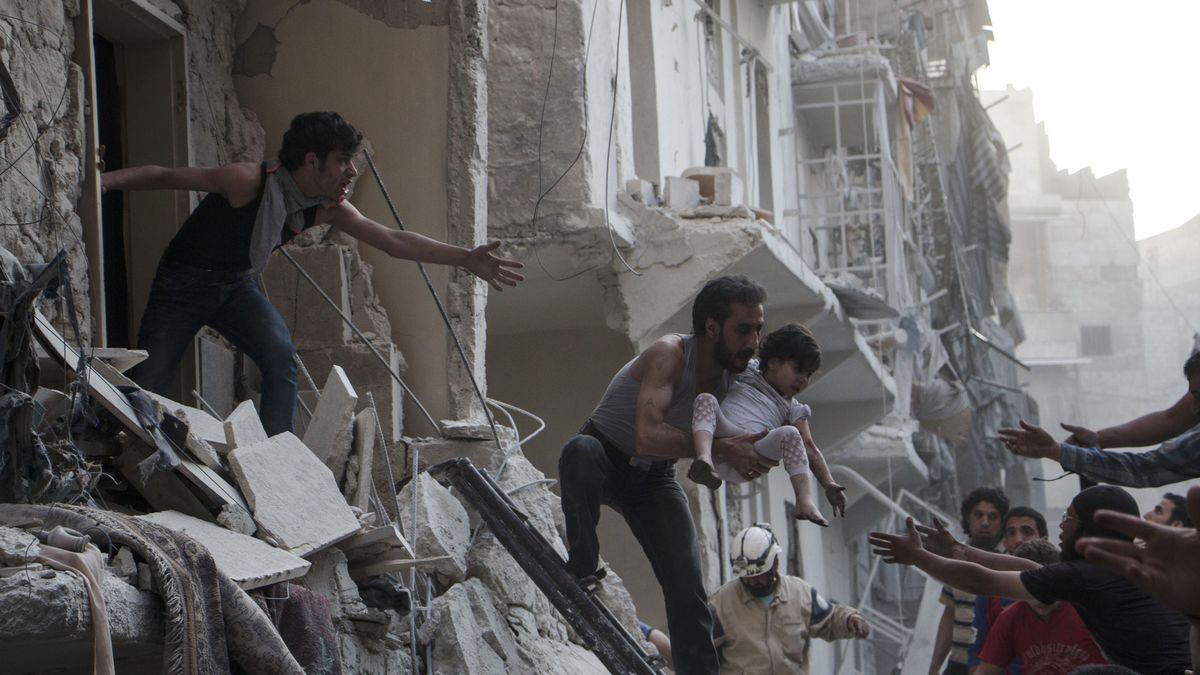In December 2010, protests erupted in Tunisia, triggering similar demonstrations across the Middle East and North Africa, including in Egypt, Libya, Yemen and Syria. Ten years since the start of the Arab Spring, photographers who captured the years of uprising reflect on what they saw and what the events of the time meant to them.
Manu Brabo is an award-winning Spanish photojournalist who covered the uprisings in Libya and Syria. He tells the story of a photograph he took in Aleppo in 2012.
It was October 3, 2012, in the second year of the uprising against Bashar al-Assad’s government. Despite the efforts of the Syrian Armed Forces, the regime was losing control of vast areas of territory to the several armed groups fighting under the banner of the Free Syrian Army (FSA).
In those days, large parts of Aleppo were under rebel control. In the rebel-held neighbourhood of Saif al-Dawla, fellow journalists James Foley, Zack Baille, Antonio Pampliega and I had converted a three-bedroom dwelling into our base of operations during those first months of combat in the city (without worrying too much about the whereabouts of the owner).
The building also housed two units of an armed group embedded in the FSA that operated in the zone, which included the fronts of Izaá, Amariya, Salahadeen and also Saif al-Dawla.
That morning, at around 6am, three young members of the FSA came to our apartment looking for us. “Time to go,” said one of the barely bearded fighters.
Antonio and I agreed to accompany the small group to the front lines, moving with some dexterity through the rubble and sprinting across each crossing on the way there.
We needed to make contact with another FSA unit that had a small group of regime soldiers trapped inside a building. They had spent the entire night exchanging both bullets and words. And they did not give up. In the morning, they launched an assault on the building, doing so without hesitation: Molotov cocktails, grenades and loads of machine-gun fire. Finally, the building was cleared.
Antonio and I captured the entire operation in pictures and, even though it was early, around 10am, I considered that the day had been a good one. The only thing remaining was to return to the apartment, edit what we had shot, and embark on our small daily adventure to reach the location where activists against the regime had set up a media centre – so we could send our material out to the world using the poor internet they managed to get for us.
But little did I realise that my work had just begun. Later that same day, I would take this photo in front of Dar Al Shifa Hospital.
The night before, three new colleagues had arrived in the city: Favio Bucciarelli, Cesare Quinto and Maysun. I offered to, in some way, be their guide since I had been working in and out of the city since the end of August. But our first and only stop was the hospital.
Dar Al Shifa was a five-storey building whose ground floor and basement were used to attend to patients. The first and second floors were for the staff, and beyond that, the floors above had been destroyed by the shrapnel of countless air strikes trying to target the place.
At the hospital, we had built a good relationship with local health workers and volunteers. A hospital is always a great place for a journalist to start, regardless of the conflict. And it’s a much better place to start at than to end up at.
I was talking and drinking tea with some volunteers in the reception hall when a large, strong man came through the entrance carrying a child, who looked to be around 11 years old. From the staff’s reaction, the situation was dire: they opened up a path through the rows of wounded people who flooded the hospital’s main hallway every day.
Surrounded by doctors and nurses, the two got lost down the hall that led to the rudimentary emergency room. The door closed behind them, and the screams became silence. I kept chatting with one of the volunteers. A few minutes later, another man walked in, this one younger, cleaner and leaner. He was extremely agitated, nervous, tense – barely able to hold back his tears.
“That’s the dad,” the volunteer I was chatting to, told me. I stood there, anticipating the conclusion, and wondering about how I would approach the photo opportunity I knew would come in the next few minutes: that of a torn father from whom the war had stolen a child.
The door of the ER opened, and the sharp sound of wailing arrived with it – cries, screams of anger and resentment. The man’s son had died. He walked out, with tears of sadness, powerlessness, and disbelief distorting his face. He carried his son in his arms – in the same way he had many times before when taking him to bed – crossing the hall towards the front door, where he crumbled.
No one got close to him, everyone gave him space, as if by standing apart we would be respecting his pain more, as if everyone knew that in that moment there was no consolation to be found, no hug that would comfort.
The four photographers there took shots timidly. It is not even easy to aim the camera when there’s so much pain. The man collapsed on his legs, grieving the still-warm body of his son, looking for the privacy of a street full of rubble. This was the live image of a cry for mercy. I photographed; first with the 24mm, then with the 50mm lens. Then I left.
But, the sequel is somewhat longer and more painful: In that street full of rubble and shelled buildings, the man wandered with his son in his arms as he waited for transportation that would take him home. He sat on a sidewalk, carrying his son’s lifeless body. Around him, people walked by, raised their gazes momentarily, then continued walking with the resignation of someone who has seen the same sight too many times before.
We, the group of photographers, looked from afar, with our souls shrunken and in silence, trying to make peace with our craft and its painful contradictions.
I remember that the drive back to the apartment was in silence. No one spoke in the car. In some way, we were hit by that overwhelming display of pain, and in part – at least for me – aware that I had one of those photos that told the story well. That night, thanks to a USB modem we had taken from one of the regime soldiers captured that morning, I was able to send a set of very low-resolution photos to my editor.
The lasting, and best, memory that this photo has given me is the many messages from random people who have looked at it and then talked to me about pain, about empathy, about their desire to hug their children tighter, or to love them more, or to be conscious and active so, in some way, no one in the world will have to be that father on the sidewalk ever again.
But unfortunately, as time has gone by, that photo has been transformed into a mere object with other meanings, neither good nor bad, but quite apart from what it originally was.
By Manu Brabo
Al Jazeera

